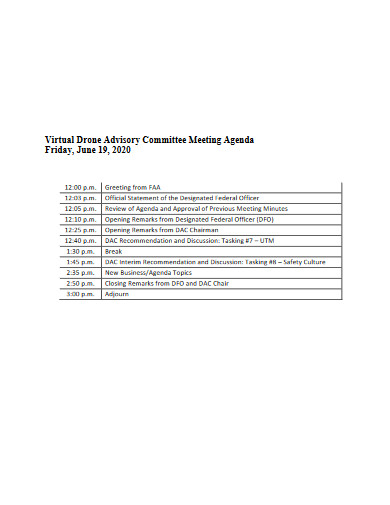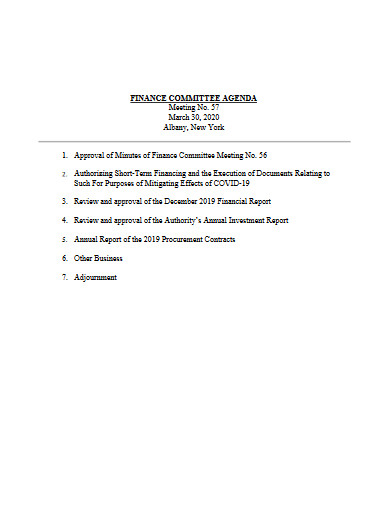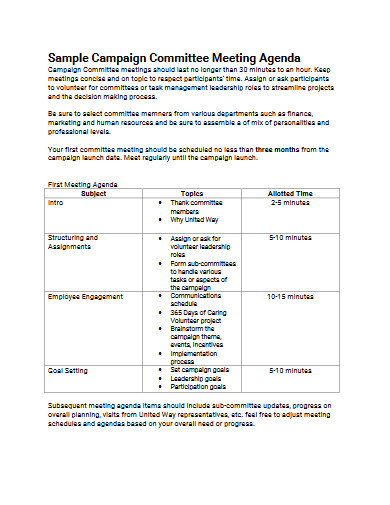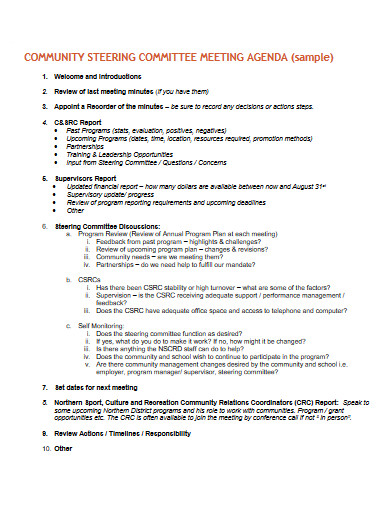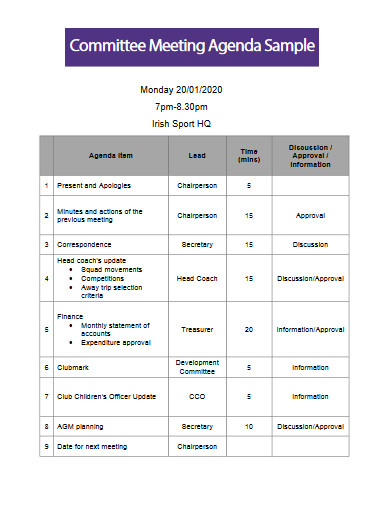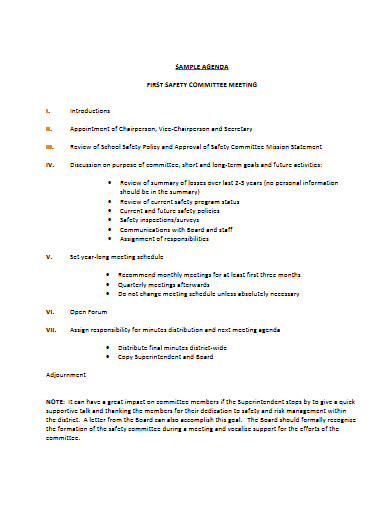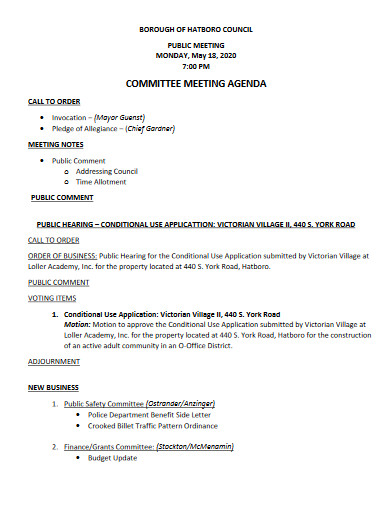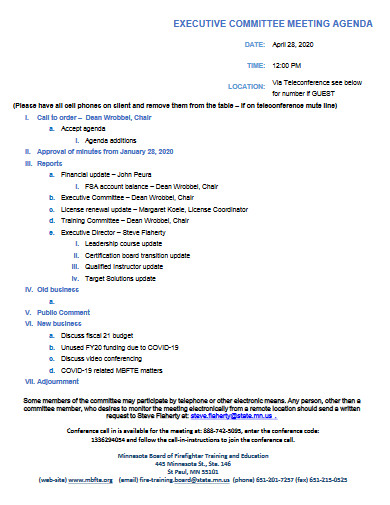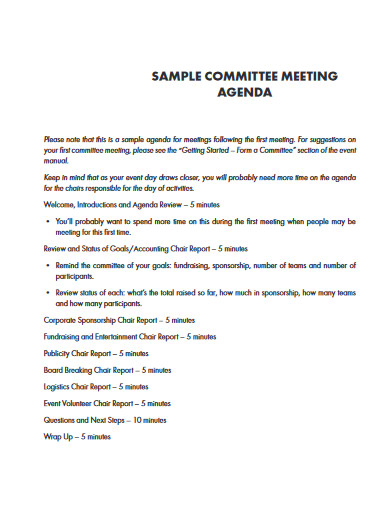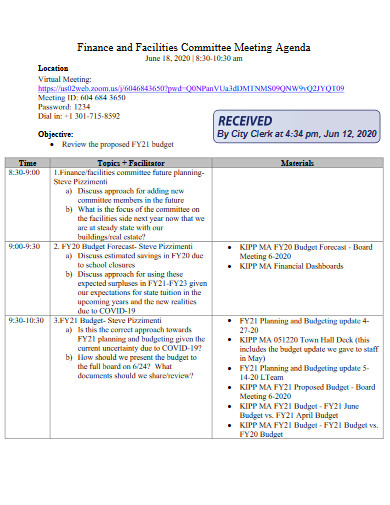10+ Committee Meeting Agenda Examples to Download
Meetings are an important part of a committee’s routine, wherever industry they may belong. It’s a way to brainstorm ideas, review previous actions, plan an initiative, and produce solutions to their challenges. However, some meetings fail to fulfill those endeavors when they become a waste of time instead of a productive session. If you want to plan better team meetings, have an efficient committee meeting agenda. This allows you to decide what topics to include that will help you achieve your session’s objectives. Scroll below, check out our collection and learn a thing or two from our helpful tips on how to make this agenda.
10+ Committee Meeting Agenda Examples
1. Advisory Committee Meeting Agenda
2. Finance Committee Meeting Agenda
3. Campaign Committee Meeting Agenda
4. Steering Committee Meeting Agenda
5. Committee Meeting Agenda Sample
6. Safety Committee Meeting Agenda
7. Committee Meeting Agenda Example
8. Executive Committee Meeting Agenda
9. Tenders Committee Meeting Agenda
10. Sample Committee Meeting Agenda
11. Facilities Committee Meeting Agenda
What Is a Committee Meeting Agenda?
A committee meeting agenda contains the outline of topics to be discussed during a committee session. The word “committee” refers to a group elected or assigned individuals to fulfill certain duties and responsibilities, whether in a community, in an establishment, or within a company. The committee meeting agenda is a pre-prepared document that provides the group with a clear flow of the meeting session. This helps their meeting become more focused and achieve their set goals in the process.
How to Plan Effective Meetings
According to Doodle’s State of Meetings Report in 2019 that was featured in Inc, America will lose a staggering $399 billion in unproductive meetings during the year. This huge waste is accounted for meetings that take too much time but don’t show any positive results and can potentially be a waste of working hours in businesses. Considering this amount, poorly structured meetings are indeed a problem every industry should overcome. Here are some ways on how you can plan a meeting effectively:
1. Send reading materials in advance. If you’re meeting involves lengthy documents and several report review, you might want to to send your participants copies in advance. Send the document three days to a week to give them ample review time.
2. Determine the decision-makers. When you’re holding a voting system during the meeting, be sure to identify the voters or decision-makers beforehand. You might have items where everyone can vote, and there may be others that only need the managers’ approval.
3. Avoid vague agendas. Unless it’s supposed to be a surprise or an impromptu meeting, avoid being vague on your agenda and settle the participants’ expectations with a clear objective.
4. Avoid straying from the topic flow. If you want to have a topic-focused discussion that finishes on time, avoid straying away from your topic flow by detouring to other impertinent topics.
5. Have a meeting summary. A meeting summary contains all the important points discussed during the meeting. To help the participants remember about the topic, distribute a meeting summary copy.
How to Make a Committee Meeting Agenda
If you want to establish an efficient committee meeting agenda, we have useful tips for you:
1. Settle Your Goal
Begin your agenda by determining what goal you hope to accomplish through your meeting. As a committee, identify your objectives. This will also serve as your session’s focus and will be your basis in identifying the different subtopics. If it’s a script meeting for a multimedia project, your focus might be on the plot changes. If it’s a company’s board meeting, your goal might be to settle your expansion details. If it’s a school club meeting, you might be talking about a project plan for an exhibit. Doing this helps you focus on the results you want to get out of the gathering before it has even started.
2. Create a Logical Topic Flow
Now that you have your objective ready, it’s time to determine what topics you want to discuss according to your goal. You can have predetermined pointers at hand, but if you want to make it more relatable and engage your meeting attendees, ask for suggestions. Share your agenda’s goal and gather feedback. When you’ve finalized your list, avoid arranging them in random order. Instead, create a logical topic flow. Find out how your topics connect and establish a path of succession. For example, if your company follows a regular weekly meeting schedule to gather updates from your group, you might want to start by asking for improvements and then proceeding to their challenges.
3. Avoid Overwhelming Your Agenda
Beware of overwhelming your agenda with too much topic than you can carry for a certain period. It’s never good to overhaul on your subjects. Can you imagine sitting through a very long session with a long list of agenda items? That’s draining. It might fail to deliver the right message. It’s also no good to rush a presentation just to fit it into a schedule. It’s best to list enough number of topics that allow you to discuss each under limited time thoroughly. So, instead of having a long departmental meeting, take the initiative to divide it into two or more sessions to keep it brief and engaging.
4. Prepare Your Logistics
Your logistics include the meeting schedule, the venue, and the people involved in the event. This is an important thing to settle before the meeting to help you identify who to invite and what details to include in the meeting invitation. Informing the attendees in advance about the meeting agenda is crucial because you wouldn’t want to surprise them. This is especially important during formal meetings where employees are sometimes asked to share their business proposal to the crowd. Never caught them off guard and inform them weeks before the actual date.
FAQs
What is a “call to order” meeting command?
A “call to order” meeting command means it’s time to discuss the agenda.
What are the elements of a meeting agenda?
The elements of a meeting agenda are the objective statement, list of topics, needed materials, participants and their roles, and the logistics.
What are the different types of agendas?
The different types of agenda are informal agenda, formal agenda, prioritized agendas, and timed agendas.
It’s important to ensure that meetings result in a productive result at the end of every session. By employing an efficient committee meeting agenda, you’ll be able to discuss topics relevant to the objective and provide the right solutions or answers to the problem. Get yours now from our committee meeting agenda templates and be rewarded with the best deals. Download now!



